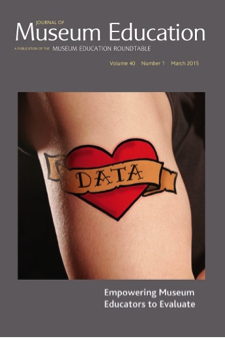Hello from Laureen Trainer, Principal of Trainer Evaluation in Denver and Joy Kubarek, Vice President of Learning for Shedd Aquarium in Chicago. We both came from museum education backgrounds and now find ourselves in the world of evaluation where we work to improve museum practice, advance our industry, and demonstrate value. We are also passionate about making sure those who do not consider themselves evaluators, but who are tasked with the role of evaluating in museums, i.e. museum educators, are brought into the discussion and supported by the evaluation community.
The environment of accountability and outcomes-based work came to museums a little more slowly than other industries, but it is here now and museums feel the pressure to demonstrate impact to their communities, learners and funders. This demands that more attention be paid towards evaluating programs, which generally falls to museum educators. However, museum educators rarely have “evaluator” in their job title and in their job description it lands under “other duties as assigned.” All too often, this means that the people in charge of evaluation in museums are challenged by a lack of time, resources, and/or experience.
We hoped to address this situation by offering an entry point for museum educators who were grappling with what it meant to evaluate and where to start. Our guest-edited issue of the Journal of Museum Education (JME), Empowering Museum Educators to Evaluate, provides a range of case studies highlighting how others have faced the challenges of conducting program evaluation in museums and gives museum educators practical tools and techniques to maximize their efforts. The case studies emphasize how to approach evaluation within an environment of limited time and resources, from building staff capacity, to developing standardized evaluation methods, to communicating results.
Hot Tip: Just because your project falls through doesn’t mean that it can’t live on in another form. Originally we were asked to contribute evaluation case studies to a larger book project, which never came to fruition. Rather than letting our work, and the work of other contributing authors sit on a hard drive, we approached the JME to publish our case studies as an issue.
Hot Tip: The JME had never published a case study only issue before, but we believed this was the best approach for our audience. So, we wrote a proposal outlining what we hoped to achieve and why we believed case studies were the appropriate method for delivering information to museum educators who were de facto evaluators, and the editorial board agreed.
Rad Resource: Check out this issue of the JME. 
Rad Resource: Join us and learn more about this topic during the free Ed-Com Virtual Book Club on April 16th.
Do you have questions, concerns, kudos, or content to extend this aea365 contribution? Please add them in the comments section for this post on the aea365 webpage so that we may enrich our community of practice. Would you like to submit an aea365 Tip? Please send a note of interest to aea365@eval.org . aea365 is sponsored by the American Evaluation Association and provides a Tip-a-Day by and for evaluators.

Good afternoon! My name is Kaitlyn Osborne and I am a last semester student at Texas A&M University-Central Texas. My degree will be in Psychology with a minor in Criminal Justice. I personally love museums and all that it brings to the public. I think that anytime a museum can reach out to society, they should jump on it. For instance, anything that promotes hands on learning with children would only benefit our youth and museums. Also, I once went to a wedding that was held in a museum. Although, it seems unorthodox, the fact that they had the bones of a T-Rex standing over them while they exchanged “I do”, made their wedding unique and memorable. Children outreach and all types of events held in a museum would be great to get the word out.
Date night in a museum would be a great event as well!
I had the wonderful opportunity to visit the famous Balboa Park in San Diego, CA. There was an abundance of museums and artistry through the park (most free to view). We did get to venture through the Natural Science Museum. They had different stations for interaction to describe the drought in California. Our favorite were the mechanical devices that required the use of our physical activity to demonstrate the energy used to distribute water. My son and I always find museums that explore the use of hands-on activity. Museums are excellent resources for children to discover history.